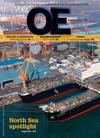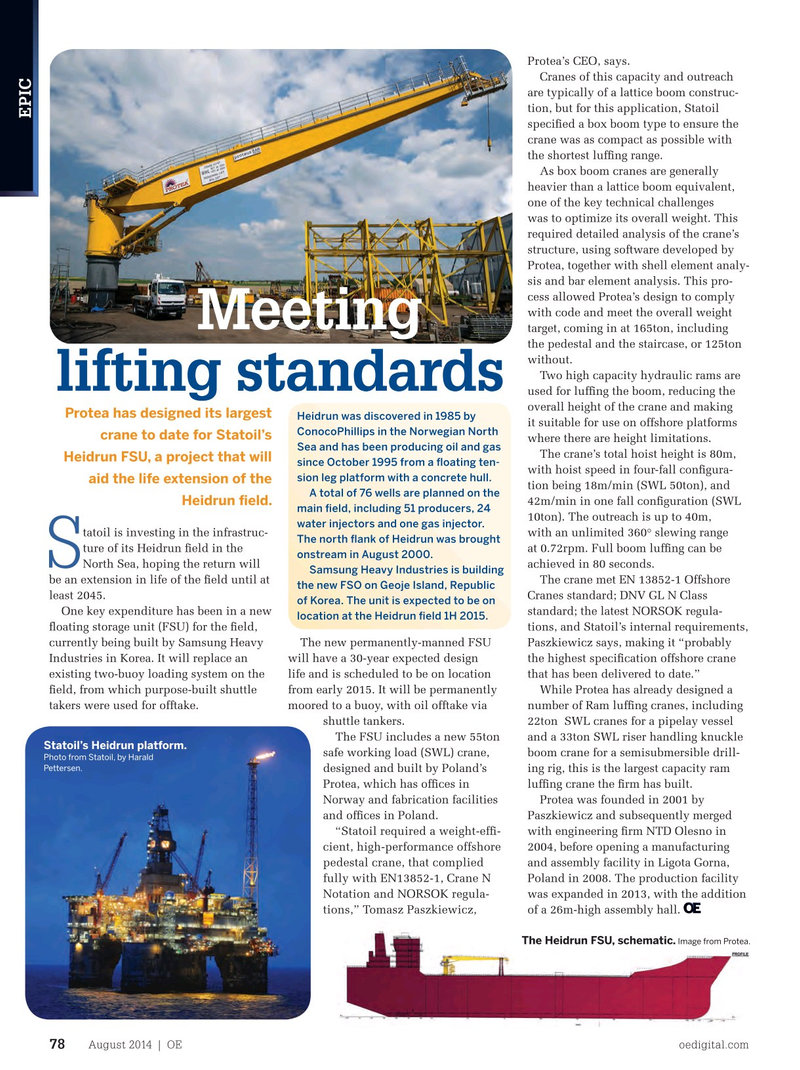
Page 76: of Offshore Engineer Magazine (Aug/Sep 2014)
Read this page in Pdf, Flash or Html5 edition of Aug/Sep 2014 Offshore Engineer Magazine
EPIC-3 - Protea
For OE magazine, August, 2014 [589 words] [byline] Elaine Maslin [images]
EPIC-3-? g1 – The Heidrun FSU crane in Protea’s yard, Poland. Photo from Protea.
EPIC-3-? g2 – The Heidrun FSU, schematic. Image from Protea.
Protea’s CEO, says.
EPIC-3-? g3 – Statoil’s Heidrun platform. Photo from Statoil, by Harald Pettersen. [hed]
Cranes of this capacity and outreach are typically of a lattice boom construc- [stand? rst] tion, but for this application, Statoil
EPIC [copy] speci? ed a box boom type to ensure the crane was as compact as possible with the shortest luf? ng range.
As box boom cranes are generally
Heidrun was discovered in 1985 by ConocoPhillips in the Norwegian North Sea and has been producing oil and gas since October 1995 from heavier than a lattice boom equivalent, a ? oating tension leg platform with a concrete hull. one of the key technical challenges
A total of 76 wells are planned on the main ? eld, including 51 producers, 24 water injectors and one gas injector. The north ? ank of Heidrun was to optimize its overall weight. This was brought onstream in August 2000.
required detailed analysis of the crane’s
Samsung Heavy Industries is building the new FSO on Geoje Island, Republic of Korea. The unit is expected to be on location at the structure, using software developed by
Heidrun ? eld 1H 2015.
Protea, together with shell element analy- sis and bar element analysis. This pro- cess allowed Protea’s design to comply with code and meet the overall weight Meeting target, coming in at 165ton, including the pedestal and the staircase, or 125ton without.
Two high capacity hydraulic rams are lifting standards used for luf? ng the boom, reducing the overall height of the crane and making
Protea has designed its largest
Heidrun was discovered in 1985 by it suitable for use on offshore platforms
ConocoPhillips in the Norwegian North crane to date for Statoil’s where there are height limitations.
Sea and has been producing oil and gas
The crane’s total hoist height is 80m,
Heidrun FSU, a project that will since October 1995 from a ? oating ten- with hoist speed in four-fall con? gura- sion leg platform with a concrete hull. aid the life extension of the tion being 18m/min (SWL 50ton), and
A total of 76 wells are planned on the 42m/min in one fall con? guration (SWL
Heidrun ? eld. main ? eld, including 51 producers, 24 10ton). The outreach is up to 40m, water injectors and one gas injector. tatoil is investing in the infrastruc- with an unlimited 360° slewing range
The north ? ank of Heidrun was brought ture of its Heidrun ? eld in the at 0.72rpm. Full boom luf? ng can be onstream in August 2000.
S
North Sea, hoping the return will achieved in 80 seconds.
Samsung Heavy Industries is building be an extension in life of the ? eld until at The crane met EN 13852-1 Offshore the new FSO on Geoje Island, Republic least 2045. Cranes standard; DNV GL N Class of Korea. The unit is expected to be on
One key expenditure has been in a new standard; the latest NORSOK regula- location at the Heidrun ? eld 1H 2015.
? oating storage unit (FSU) for the ? eld, tions, and Statoil’s internal requirements, currently being built by Samsung Heavy The new permanently-manned FSU Paszkiewicz says, making it “probably
Industries in Korea. It will replace an will have a 30-year expected design the highest speci? cation offshore crane existing two-buoy loading system on the life and is scheduled to be on location that has been delivered to date.” ? eld, from which purpose-built shuttle from early 2015. It will be permanently While Protea has already designed a takers were used for offtake. moored to a buoy, with oil offtake via number of Ram luf? ng cranes, including shuttle tankers. 22ton SWL cranes for a pipelay vessel
The FSU includes a new 55ton and a 33ton SWL riser handling knuckle
Statoil’s Heidrun platform. safe working load (SWL) crane, boom crane for a semisubmersible drill-
Photo from Statoil, by Harald
Pettersen. designed and built by Poland’s ing rig, this is the largest capacity ram
Protea, which has of? ces in luf? ng crane the ? rm has built.
Norway and fabrication facilities Protea was founded in 2001 by and of? ces in Poland. Paszkiewicz and subsequently merged “Statoil required a weight-ef? - with engineering ? rm NTD Olesno in cient, high-performance offshore 2004, before opening a manufacturing pedestal crane, that complied and assembly facility in Ligota Gorna, fully with EN13852-1, Crane N Poland in 2008. The production facility
Notation and NORSOK regula- was expanded in 2013, with the addition tions,” Tomasz Paszkiewicz, of a 26m-high assembly hall.
The Heidrun FSU, schematic. Image from Protea.
August 2014 | OE oedigital.com 78 078_OE0814_EPIC3_Protea.indd 78 7/22/14 6:35 PM

 75
75

 77
77